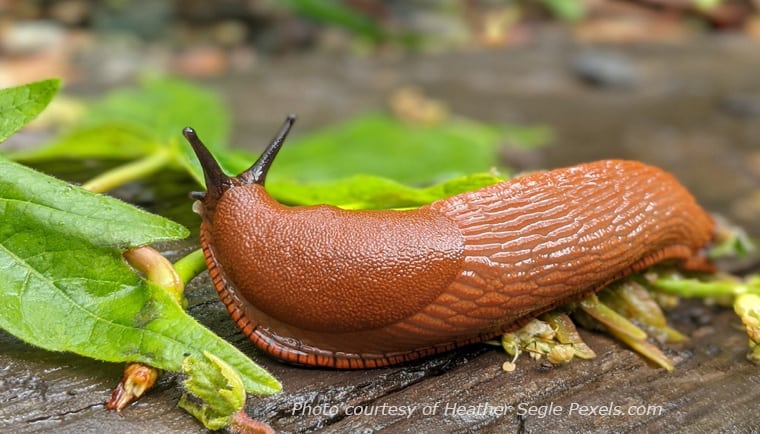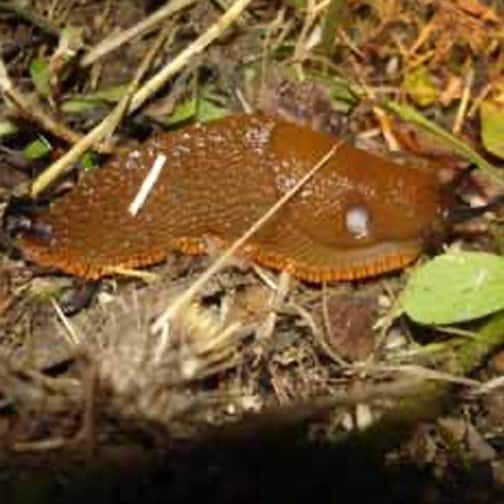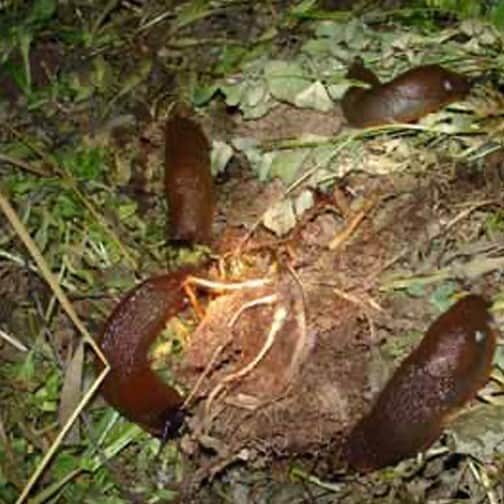Midnight Marauders


Midnight Marauders
Managing Those Pesky Slugs and Snails
By Diana Wisen, Skagit County WSU Extension Master Gardener
Pacific Northwest gardeners probably spend more time discussing slug damage than almost any other garden problem. Slugs require moisture in the soil and vegetation, both of which are abundant in our area.
During cold or dry weather, they can move down into the soil. Adult slugs and snails live through the winter in this region, seeking shelter underground. In dry or hot weather, they can borrow down as much as 6 feet to find cool dampness. They can seal themselves off with a parchment-like membrane for protection from the elements. They are Gastropods from the Greek meaning “belly foot”.
Most of the slugs and snails you see in your yard are non-native, invasive varieties. The native Banana slug, a good guy, is found mostly in wooded areas, not suburban landscapes, and tends to eat only decaying matter. There are many species of non-native slugs that attack your plants.

Two of the most destructive are the common gray field slug, genus Arion (several colors of these large slugs), and the brown snail that is becoming more common as it can survive drier conditions easier than slugs.
Slugs eat young vegetables starts, strawberries, daffodils and tulips, and many other things, with new dahlia shoots and marigolds being among their favorites. You have to start early and be vigilant in your efforts to manage the slug and snail population in your yard. There is no such thing as just one slug. Slugs can lay anywhere between 30 to 100 eggs at a time, several times a year, mostly in late summer. Slugs are hermaphrodites: adults have both female and male organs, so all can lay eggs. Sometimes the eggs hatch right away and other times they hatch the following spring. Look for clusters of tiny, pearl-like eggs beneath leaf debris, boards, garden pots, and other damp places and crush them immediately.
Those little eggs will soon turn into ravenous baby slugs which eat 30-40 times their body weight every day! Their teeth are like a rasp that shreds the vegetation as they glide along. Slugs tend to come out at night or on cloudy days when it is cool and damp. This is your clue as to when to head out to hand-pick. However, only about 5% of the slugs are above ground at any given time, thus making control efforts difficult and ongoing.
There are five main types of control and for best results, you may have to utilize all of them, though you will never be able to eliminate slugs completely.
Biological:
Some predators eat slugs. Toads, frogs, snakes, and beetles will eat small slugs, so encourage them in your yard. Sometimes chickens and wild birds will eat baby slugs, but gag on large slugs. Ducks and geese eat slugs, but this poultry solution is not for everyone.
Cultural:
Change the conditions so the area is not conducive to slugs. Keep the soil dry. Mow nearby meadows or grassy areas. Keep a 6-foot-wide strip of dry, bare ground around your vegetable garden, use arborist chips for pathways, till your soil in early spring to expose the slug eggs, and plant things that slugs tend not to eat. Crushed eggs shells, ashes, and diatomaceous earth do not work. The slug’s mucus thickens to protect it from sharp surfaces.
Mechanical:
People love to talk about their favorite tools for slug control.
- A sharp shovel or weeding tool, a Hori-Hori knife, an old kitchen knife or scissors, or a hoe. Keep them all handy. Many people regularly go out at night or early morning with a bucket of soapy water on a search and destroy mission. The frequency is up to you, but the more often the better the results. Be sure to wear disposable gloves as slugs carry diseases such as Salmonella. Be sure to keep a lid
on the container.
- A wide band (3”) of copper tape firmly attached around the base of containers and raised beds will prevent slugs from climbing up. They will not cross copper. But make sure there are no slug eggs in the soil already in the pot!


Chemical:
There are many products on the market to kill slugs and snails. Read the label before purchasing and using it at home. Follow the directions exactly. The newer products are distributed differently than was done with the products of a few years back. Newer products use ferrous (iron) phosphate as the active ingredient and require only sprinkling sparsely over an area. Slugs are attracted to the bait, they eat it, and it makes them stop eating and slither away to die. You won’t see the dead bodies, but after a few days, you will notice the damage has stopped. These newer products remain active for up to 2 weeks, even if it rains. They are safe to use around children, pets, and wildlife.
There are some products available that use metaldehyde as the active ingredient and it works very well, but they can be poisonous to children, pets, and wildlife.
Home Remedies:
Do not use salt. Slugs rehydrate and salt damages your soil and plants. Fermenting yeast attracts slugs, so some people use beer. You provide the party, and the slugs show up, drink their fill and drown. It has its advantage. The slugs come to you; you don’t have to go out looking for them. You can use a cottage cheese carton, cut a couple of openings in the side, set it in the ground up to those holes, fill it with beer or your homemade brew, and put the lid on. Check and empty it every couple of days. Slugs are also attracted by the smell of dead slugs and show up to join the party. Keep your dog away since dogs are known to slurp up the whole thing, dead slugs, and all. You can use old beer, but not wine or stale beer. Apple vinegar sometimes works. You can also make your own fermenting recipe: 1 Tbsp brewer’s yeast or baking yeast, 1 Tbsp sugar, 2 Tbsp flour, and 2 cups tepid water. Mix and allowed to stand for an hour or so. It will last for 2 or 3 days.
Remember it takes regular attention and vigilance to manage slug and snail populations. Keep at it and over the years you will see a decline in the numbers you have in your yard.
About the Author:
Diana Wisen is a Skagit County WSU Extension Master Gardener and is the Coordinator of the Fuchsia Garden at the Discovery Garden on SR 536 in Mount Vernon.
References:
Gordon, David George. 2010. The Secret Life of Slugs and Snails-Life in the Slow Lane Sasquatch Books, Seattle, WA
"Managing Slugs and Snails” State University- 10-Minute University OSU Master Gardener Program and OSU Extension Service
Those Pesky Slugs” Article by Mary Robson King County Area Extension Agent (now retired) May 2000
Schenk, George. 2002. The Complete Shade Garden. Timber Press, Portland, OR
Questions about home gardening or becoming a master gardener, may be directed to: WSU Skagit County Extension Office, 11768 Westar Lane, Suite A, Burlington, WA 98233; by phone: 360-428-4270; or via the website: www.skagit.wsu.edu/mg
Washington State University Extension helps people develop leadership skills and use research-based knowledge to improve economic status and quality of life. Cooperating agencies: Washington State University, U.S. Department of Agriculture, and Skagit County. Extension programs and policies are available to all without discrimination. To request disability accommodations contact us at least ten days in advance.